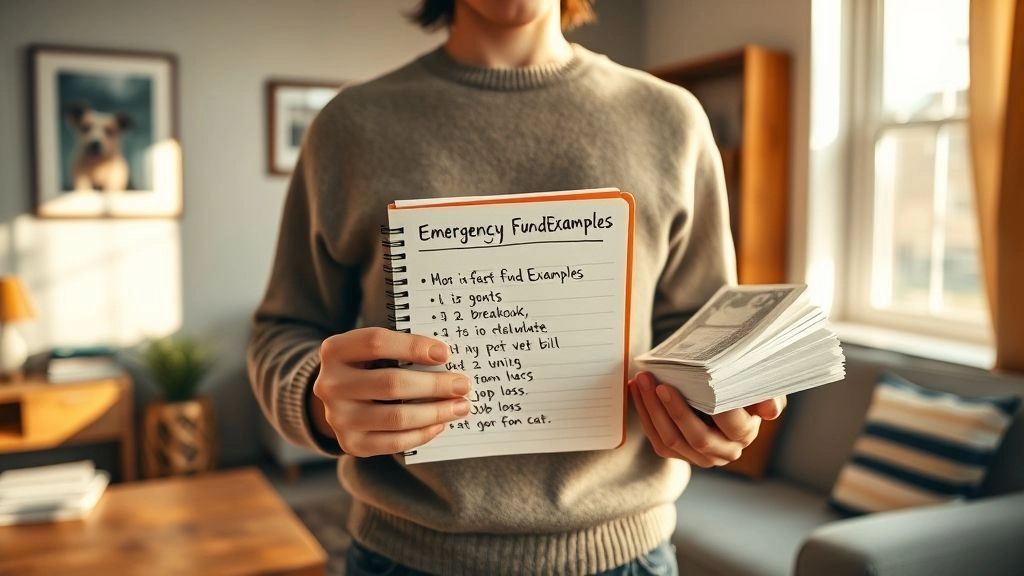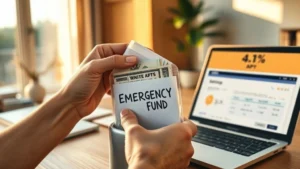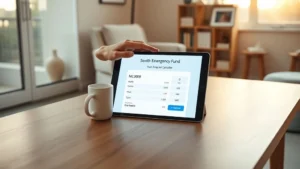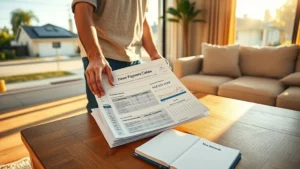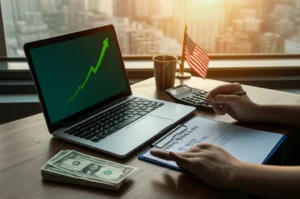Honestly, Didn’t See It Coming
Let’s start with something real. Have you ever looked at your bank app and thought, “I’m fine… until, well, something completely random tanks my whole month”? I did. Let me paint you a very ordinary picture: My old sedan, “Blueberry,” decided she was done with her starter. I thought—oh, a little car trouble, can’t be too bad. But the shop called. The bill was brutal. My stomach dropped. That was the exact moment I realized how thin my so-called “buffer” really was.
Most of us—whether you’re living on tight lunches and bus rides, or you’re already channeling your inner coupon queen—think, “Oh, emergencies, they’re rare, I’ll deal with it when it happens.” But here’s the subtle mistake so many of us make: Praying nothing big happens is not a strategy. An emergency fund? It is. Let’s break this down and get into real emergency fund examples (including mine), some quirky anecdotes, and a bunch of practical lessons you can swipe for yourself.
So, What’s “An Emergency,” Anyway?
Does This Count, Or Is It Just A Craving?
It’s wild how we all draw the line differently. Your neighbor might think a broken phone is a full-blown emergency; your grandma probably only cracked hers twice in two decades. But some things… Well, they’re just universal gut-punches.
Think: Car won’t start the morning of that Big Interview. Surprise dental bill—out of nowhere. Your dog swallows a sock and now, you’re at the animal ER at midnight praying and Googling pet insurance. A big chunk of folks over at hermoney.com shared stories that literally hit home: the disabled child needing out-of-town care, the tax bill out of left field, even the pet crisis—people actually had their savings ride to the rescue, not just once, but again and again.
| True Emergencies | Definitely Not Emergencies |
|---|---|
| Busted water heater in January | The latest iPhone sale (ouch, FOMO) |
| Surprise vet bill for your four-legged favorite | Extra side salad at brunch |
| Major car breakdown | Impulse outfit for Friday night |
If your gut says, “This could tank my bills, derail my job, or put a loved one at risk…” Yeah. That’s an emergency fund moment.
How Much Is “Enough”?
Should You Shoot For $1,000 Or $30,000?
I hear this all the time. And the truth? It depends way more on your own life than what financial “experts” declare online. That being said, classic advice (and honestly, it tracks) is: aim for three to six months of essential expenses—rent, food, insurance, the boring stuff. For some people, that’s $3,000. For some, a $30,000 emergency fund makes sense if you have a family, a house, or a business riding on your shoulders.
But starting smaller isn’t “wrong.” Canada’s government has this amazing illustration—just $10 squirreled away each week? That’s $520 at the end of the year. Doesn’t sound like much, but when your tire pops or your phone dies for good, it suddenly buys breathing room. The real emergency fund examples aren’t about having stacks of cash; it’s the fact you have something to catch you before you hit the rocks.
Not sure how much that is for you? Plug your bills into an Emergency fund calculator. Trust me, running those numbers—seeing your “bare-minimum” budget in black and white—feels like opening the door to your future with less dread and more “yep, I can pull this off.”
| Type | Weekly Save | Annual Emergency Fund |
|---|---|---|
| Tight budget (ramen life) | $5 | $260 |
| Moderate | $10 | $520 |
| Going all-in | $20 | $1040 |
Start where you can. Even a “starter” emergency fund (say, $1,000) is better than another maxed-out card.
Everyday Emergency Fund Examples (That’ll Happen Eventually…)
An Epic Car Breakdown and The Aftermath
Okay, storytime. This one is mine—remember Blueberry, my (formerly) trusty ride? There I was, one Tuesday morning, suited, caffeinated, and, for once, on time. Instead? Blueberry sputters, coughs, flatlines. The repair shop’s number isn’t even saved because denial is strong. The bill? $1,460. If I hadn’t had about $1,250 in my emergency stash, my week would’ve turned into an episode called “Guess Who’s Commuting By Skateboard.” But I didn’t have to panic. I used the fund, trimmed my grocery list for a bit, and rebuilt it over the next few months. Was it fun? Absolutely not. Was it night-and-day better than watching my credit card interest compound? Absolutely.
Lots of people on Reddit and around the web have similar tales—like the person who had to fly across the country for a family emergency, or the pet owner staring down a four-figure vet bill. Even in more dramatic cases—disasters like a tree hitting your house, as described by this doctor’s real story—having that money wasn’t just practical, it was peace of mind when everything was loud and scary.
| Emergency | Real Cost | Fund Recommendation |
|---|---|---|
| Car breakdown (basic repair) | $500–$1500 | Start with $1,000 |
| Pet medical emergency | $300–$2,500 | At least 1–2 months’ expenses |
| Job loss | 3–6 months’ living costs | Go bigger when you can |
Still Think It Won’t Happen To You?
Listen to Beth Anne over at hermoney.com—her family used their emergency fund to get their disabled child to doctors hours away, covering hotels and unexpected travel when life took a sharp turn. Others mention using their stash to escape abusive relationships, move states after job loss, or tackle jaw-dropping medical bills.
Where’s The Best Place To Keep It?
Why Hiding It In Checking Doesn’t Work
Temptation is real. If your emergency money sits right next to your coffee money, you will probably touch it on a really bad (or really good) day. Not great. The best tip? Keep it close—but not too close. A separate savings account means one extra step to move cash out (the right kind of friction), but when you need it, you’re not scrounging for change or waiting three business days.
Seriously, if you’re wondering why shouldn’t you keep your emergency fund money in your checking account?, it’s because out of sight (mostly), out of mind (until you really need it). High-yield savings get an extra gold star—they add a smidge of interest and still keep your money handy for real trouble.
| Account type | Good for emergencies? | Why/why not? |
|---|---|---|
| High-yield savings | Yes | Easy to access, earns a little interest |
| Checking account | Not ideal | Too easy to spend impulsively |
| Investment account | Nope | Might lose value, slower to access |
Emergency Fund vs. Regular Savings… Not Twins!
Are You Confusing These Two?
There’s a big difference between “I need cash for my dog’s x-ray” and “I’m saving for a new sofa.” Both matter—but they play different roles. Your emergency fund is your financial seatbelt. Your regular savings? That’s for all the fun, planned stuff—trips, gadgets, Friday nights out.
Curious about the details? I love this clear comparison: how is an emergency fund similar to and different from a savings fund?. The nutshell: Emergencies = surprise; Savings = plan.
Want A $30,000 Emergency Fund? Here’s How Real People Did It
Going From $100 To Five Figures (It’s Possible… Scout’s Honor)
Let me get something out of the way—most of us won’t hit a $30,000 emergency fund in a year, or even five. But you can get there, step by step, without major suffering.
Anecdote time: My friend Jill started by stashing away $25 every payday. That’s it. Overtime, windfalls (the occasional tax refund, a surprise birthday card from Grandma), she tossed those into her “untouchable” fund too. Before she knew it, there was almost $2,000 sitting there. Then, after a work emergency (thanks, pandemic) forced a part-time downgrade, she lived off her fund for two months while job hunting. She didn’t lose her apartment. She didn’t skip meals. That little fund? Became her safety net.
Others do it by automating transfers—set $10 or $20 aside before you even see it, and it’s weird how you barely miss the money. Heck, even rolling loose change into a jar (as my dad still does) has paid off at the weirdest times.
| Savings hack | Weekly effort | Annual result |
|---|---|---|
| Auto-transfer $20/paycheck | Twice monthly | $520+ |
| Cutting one takeout meal/week | $15 | $780 |
| Seasonal windfalls (tax refund, bonus…) | Varies | Keeps fund healthy + growing |
If you ever need a little inspiration (or motivation to “go big”), browse this page on building a $30,000 emergency fund for regular people—it’s not just for CEOs and lottery winners.
Ready To Save Yourself? Here’s Your First Step
I’m rooting for you. For real. The big secret isn’t some fancy account or bulletproof budget template—it’s showing up for Future You, even in small ways. Emergency fund examples from real life show exactly what happens when you do: fewer panic spirals, less reliance on sketchy credit cards, and the kind of sleep that comes when you know one busted pipe won’t wreck your year.
So: Commit to $20 a week. Or $5, if that’s what’s real for you. Try an Emergency fund calculator to get a quick target. Keep the fund in its own corner (you know now why shouldn’t you keep your emergency fund money in your checking account?). And when in doubt, remember—every single person who ever got ahead started by being a little scrappy, a lot stubborn, and willing to save even when it felt small.
Got your own “I didn’t see that coming!” story or a favorite emergency savings tip? Tell me below or shoot me a DM. And start today—even if you’re just tossing coins into a coffee mug. You’ll thank yourself when (not if…) real life interrupts and you get to say, “Phew. I’ve got this.”

